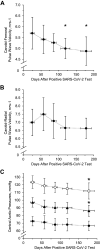Six-month longitudinal tracking of arterial stiffness and blood pressure in young adults following SARS-CoV-2 infection
- PMID: 35439042
- PMCID: PMC9126215
- DOI: 10.1152/japplphysiol.00793.2021
Six-month longitudinal tracking of arterial stiffness and blood pressure in young adults following SARS-CoV-2 infection
Abstract
Severe acute respiratory syndrome coronavirus 2 (SARS-CoV-2) can increase arterial stiffness 3-4 wk following infection, even among young, healthy adults. However, the long-term impacts of SARS-CoV-2 infection on cardiovascular health and the duration of recovery remain unknown. The purpose of this study was to elucidate potential long-lasting effects of SARS-CoV-2 infection on markers of arterial stiffness among young adults during the 6 mo following infection. Assessments were performed at months 1, 2, 3, 4, and ∼6 following SARS-CoV-2 infection. Doppler ultrasound was used to measure carotid-femoral pulse wave velocity (cfPWV) and carotid stiffness, and arterial tonometry was used to measure central blood pressures and aortic augmentation index at a heart rate of 75 beats·min-1 (AIx@HR75). Vascular (VCAM-1) and intracellular (ICAM-1) adhesion molecules were analyzed as circulating markers of arterial stiffness. From months 1-6, a significant reduction in cfPWV was observed (month 1: 5.70 ± 0.73 m·s-1; month 6: 4.88 ± 0.65 m·s-1; P < 0.05) without any change in carotid stiffness measures. Reductions in systolic blood pressure (month 1: 123 ± 8 mmHg; month 6: 112 ± 11 mmHg) and mean arterial pressure (MAP; month 1: 97 ± 6 mmHg; month 6: 86 ± 7 mmHg) were observed (P < 0.05), although AIx@HR75 did not change over time. The month 1-6 change in cfPWV and MAP were correlated (r = 0.894; P < 0.001). A reduction in VCAM-1 was observed at month 3 compared with month 1 (month 1: 5,575 ± 2,242 pg·mL-1; month 3: 4,636 ± 1,621 pg·mL-1; P < 0.05) without a change in ICAM-1. A reduction in cfPWV was related with MAP, and some indicators of arterial stiffness remain elevated for several months following SARS-CoV-2 infection, possibly contributing to prolonged recovery and increased cardiovascular health risks.NEW & NOTEWORTHY We sought to investigate potential long-lasting effects of SARS-CoV-2 infection on markers of arterial stiffness among young adults for 6 mo following infection. Carotid femoral pulse wave velocity was significantly reduced while carotid stiffness measures remained unaltered over the 6-mo period. These findings suggest several months of recovery from infection may be necessary for young adults to improve various markers of arterial stiffness, possibly contributing to cardiovascular health and recovery among those infected with SARS-CoV-2.
Keywords: COVID-19; arterial stiffness; blood pressure; carotid stiffness; pulse wave velocity.
Conflict of interest statement
S. M. Ratchford and A. S. L. Stickford now work for Medtronic, a publicly traded biomedical device company. They may hold stock within the company. However, the data obtained from this manuscript does not have direct benefit for the company and is an investigation into the structure/function of young adults recovering from SARS-CoV-2. None of the other authors has any conflicts of interest, financial or otherwise, to disclose.
Figures



References
Publication types
MeSH terms
Substances
Grants and funding
LinkOut - more resources
Full Text Sources
Medical
Miscellaneous

